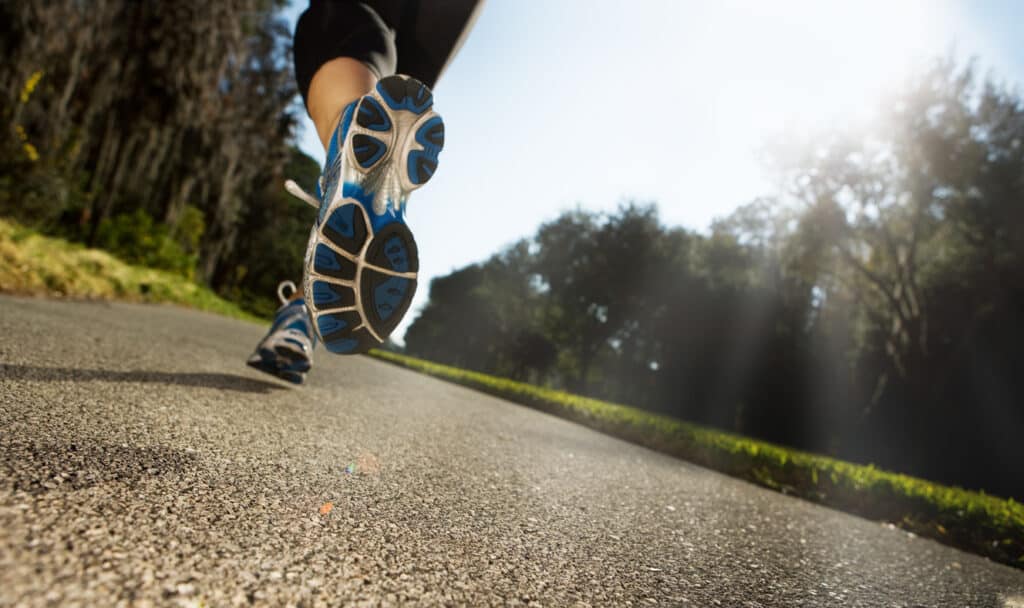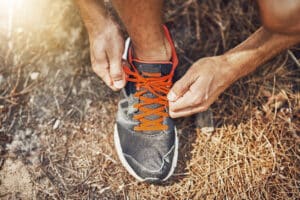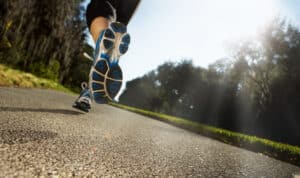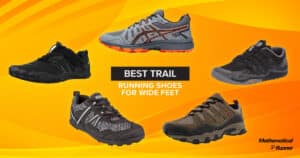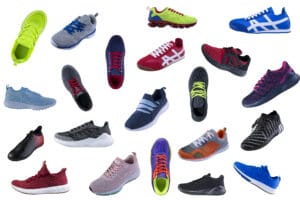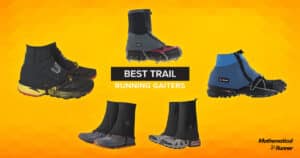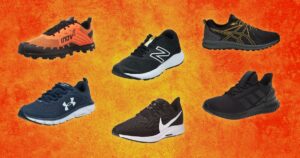Have you been enjoying trail running or into this sport and considering doing this activity on roads as well? Both these activities are different and require preparations that can be distinguished from each other. It is because these tracks differ in their surface textures where a road can be significantly hard and even, while the trail is somewhat soft and rugged.
The company manufactures a particular type of shoe considering its main purpose and target customers. Similarly, the same is the case with wearing trail running shoes and road shoes.
One can wear designs of trail running shoes that are not heavily cushioned on every side for running on roads. The shoes should have a design that provides sufficient support on the toe side as well as the ankle to be chosen for a harder medium. Moreover, they should not contain huge lugs or plastic otherwise it will be difficult to cover long distances.
In this post, I have mentioned some key pointers that are unique for both kinds of shoes. It will help you decide if the properties of your trail shoes are closer to that of running shoes.
Outsoles:

An outsole of footwear is generally made of rubber. As trails can have one of the various conditions, one might observe either running shoes for muddy trail, a rugged and uneven terrain or a rocky one. Therefore, shoes must provide enough traction for excellent grip, whether you step on a wet surface or an area full of bogs.
For this purpose, the outsoles have lengthy and thick rugs for the great support. In addition to this, they usually have sticky and firm outsoles to ensure that your feet can be balanced and stay better on rocky paths such as those built near the hills.
Hence, it is beneficial to look for this property in trail runners if you are planning to visit mountainous areas. Moreover, you should check the grooves or slots on the bottom of the outsoles, for which your preference should be the products with aggressive ridges in construction.
On the other hand, a road shoe includes an outsole made from smooth material with some elasticity such as rubber. Moreover, to facilitate a roadrunner to cover the miles smoothly, companies add hard outsoles which keep the feet in place. The outsoles of these shoes have a flatter design with numerous slots for smooth movement.
When it comes to putting on a pair of trail shoes for running on roads, one must determine the specifications of the outsoles first. If the outsoles are extremely thick with long lugs, there are high chances that they will conduct heat to the feet, resulting in painful bumps on the skin.
Running for several hours with these shoes will also increase the pressure inside leading to blisters and toe diseases. Furthermore, you can damage the inner outsole material if you do road running regularly. Thus, it will negatively affect the overall performance and quality of shoes, not even making them suitable for uneven surfaces anymore.
Upper:
Another primary part of a trail shoe to check for determining its suitability as a road shoe is the upper which mostly includes a brand logo as well. Since trails, especially mountainous or hilly tracks, are characterized by sharp rocks, the manufacturers add extra support in the uppers to save a trail runner from slipping and getting severely injured.
Some firm foam materials in the toe region serve this function. Due to this reason, they weigh more than normal shoes.
In the case of road shoes, the upper does not include extra padding and cushioning since feet require medium support. In addition, most trail running shoes are made from waterproof upper, especially those designed for muddy trails. However, this is not the case with road shoes.
They are made of thin material such as cotton and let an ample amount of air In. It makes their material both breathable and lightweight than a large portion of trail running shoes available on the market.
Midsoles:
Midsoles, as their name suggests, are present in the middle of the outer sole (between outsole and toe box). Trail runners wear shoes with midsoles that are more firm. A majority of these products contain rock plates.
These sheets are made of plastic and added to the midsoles to provide maximum protection to the feet from the bottom as they pass through rough rocks and stones.
A majority of midsoles in these products are made of EVA (ethylene-vinyl acetate) which contributes to maximum friction, significant grip, and appreciable pressure absorbance.
The soles in which this material is used contribute to more elasticity. Moreover, they are better for covering long-distance paths since they are lighter and more comfortable than rubber soles. Don’t confuse this property of trail running shoes with hiking shoes. You might have seen this material in hiking shoes as well.
To facilitate speedy movement on hard roads, road shoes are designed to give sufficient protection to both the legs and feet. Extra padding in the midsoles allows you to cover strides without feeling a burden on the soles and legs.
Moreover, they lessen the distance between the balls and heels of a runner’s feet, helping the person to move forward while removing the pressure from the toes and ankles.
Profile Of Shoes:
Also termed heel-to-toe drop or offset, the profile of footwear is the difference between the height of a toe box and heels. Many ignore this factor while choosing from a collection of shoes that a brand offers.
This aspect is also related to cushioning and is another property that you will find different in the types of shoes under consideration. The thicker the outsole at the end of shoes, the more the heel-to-toe drop of that product.
When it comes to the footwear for even and hard surfaces, this difference is more, usually between 4mm-6mm to secure the runner’s or athlete’s Achilles or the calcaneal.
It is a tendon that provides a connection between the heel bones and calf muscles. Thus, one can run freely on high-impact pavements or roads without any chance of hurting heels or muscles as they stretch to some extent while moving.
In the case of trail running shoes, the drop is lower which means your feet will stay closer to the ground. It is to ensure the best stability of bones in the foot, especially the ankles. As some areas of the trails can be unexpected at times (with rough rocks or slippery soil), companies design and develop them while evaluating these factors.
Hence, with less height difference, a person’s sense of body movement and responsiveness is enhanced significantly and they can improve their muscle coordination. They get more conscious and attentive to land type.
Medial Post:
Good-quality road shoes come with an additional part called medial post. It is also known as a guide rail or bar. As the name implies, this part is a high-density and firm foam material placed on the inside of the sole near the toe region.
The material used for making this is usually EVA due to its durability, strength, and comfortable feel. When you take steps on a hard and rough surface, there is a good chance of under or overpronation of your feet.
It means that your feet do not naturally roll and move outwards more than necessary when they land on the road.
This is how your feet and legs are protected from several painful diseases and conditions. In addition, this component of footwear promotes a smooth transition between heels to toes, leading to energetic steps through better alignment.
On the other hand, trail runners do not feature this part in their midsoles. Thus, they remove the restriction on natural foot movement at multiple angles. I presume this might have caused nervousness and concern about buying these products.
However, there is nothing to worry about since trail runners still include enough cushioning to support your body and help you get adapted to multiple kinds of terrains better which is undoubtedly favorable (for instance, rock plates). Since your motion is not limited now, you can adjust yourself to the surface easily.
Contrast In Tabular Form:
|
Characteristics |
Trail Running Shoes |
Road Shoes |
|
Outsole |
Deep and lengthy lugs |
Soft material with no lugs |
|
Upper |
Medium breathability |
Great breathability |
|
Midsoles |
EVA or more grippy rubber missiles with plates |
Less grippy rubber with a medial post |
|
Traction |
Extraordinary traction |
Average grip and friction |
Suitability:
Generally, every shoe made for running on trails can be used for road running too since they include maximum cushioning and are durable as well. However, when it comes to practice putting them on for running on pavements, most of them are not safe due to heavy padding and harder soles on the front.
For example, they come with long lugs on the front that can make it difficult for people, particularly, elders to lift their feet.
Furthermore, they are less breathable and one might struggle taking quick strides due to their considerable weight. Hence, one should only use trail shoes for multiple purposes if the product design manifests a balance between the properties of both kinds of shoes.
Now you may have a question in your mind that what you should look for in trail running shoes. For routine runs, you can choose trail runners which offer good breathability, adequate support for heels and toes, and do not put much pressure on feet such as runners with polyurethane foam in their soles or soft or hard rubber.
The rubber material is extremely helpful for those who maintain a fast pace and provide better protection when you come across some bumps or take turns. If you want to check your pace then you should use a running pace calculator.
Furthermore, in case you want to try your trail runners for tarmac paths, you should look for the products with shallow-lugged soles as compared to the ones with deeper lugs. It will prevent damage to your footwear while you run smoothly on roads and thus prolong their life.
Shoes For Both Purposes:
While designing hybrid shoes that one can wear for trail and road running, brands make sure that they provide enough cushioning for movement on high-impact areas on the road while keeping the requirement of high responsiveness and feel of the land in mind. Due to this, the products do not remain unique to a particular surface anymore and also assist people in dealing with numerous trails.
Frequently Asked Questions
Generally, a runner might not need water-resistant trail running shoes. They are made this way to lessen the probability of water being trapped in the footwear. However, many designs are waterproof and made with breathable material as well.
Though companies use a variety of materials for making the upper of running shoes such as cotton and leather, nylon is best-suited for this purpose. It allows the adequate flow of air and is durable, stretchable, and lightweight.
Yes, EVA foam or cushioning is one of the best selections for running shoes. It maintains shoe shape and dimensions due to its elastic features under large pressure and offers excellent flexibility as well as friction against uneven or hard surfaces.
Conclusion
I hope that you find this piece of writing useful and this few-minute read helps you in the future to decide when picking an appropriate item from your shoe collection. Fortunately, a lot of trail running shoes that companies introduce are also suitable for road running even though their main target is to deal with off-road areas.
You simply have to observe the design and extra materials added, which is more intense and heavy in the case of trail shoes. In addition, brands are now focusing on developing shoes that offer versatility and so you can wear trail shoes for routine road running as well without making you suffer from pain in your feet.
RELATED ARTICLES

